Before Vietnam, the helicopter was valued for its
ability to evacuate wounded soldiers from trouble, but virtually ignored
was its capabilities as an offensive weapon.
The long war in Southeast Asia would see that change dramatically.
Technically, gunships and attack helicopters are not the same, though they can share the attack role. Gunships are modified aircraft to carry weapons, while attack helicopters are designed for only that role.
 1940 / 1945 :
The helicopter during WWII was still in its initial steps of development so
it saw limited action.
1940 / 1945 :
The helicopter during WWII was still in its initial steps of development so
it saw limited action.
Great Britain and Russia did use autogiros ( based upon spaniard Cierva designs ) for observation duties but always used in small numbers.
Germany had already flown the Flettner FL 282 Kolibri , the most advanced helicopter model of this period and used it in combat for artillery spotting in Russia and for convoy protection in the Baltic and Mediterranean Sea so early as 1941. In the US, the Coast Guard was dropping practice bombs from a Sikorsky R-4 / YH-4A in early test as a weapon against submarines and the US Army succesfully complete a medevac (medical evacuation) mission in Burma at the ends of WWII using an YR-4.

An early link in the history of the helicopter gunship, was the proposal by Platt-LePage Aircraft to build a single seat dedicated gunship helicopter. This 1940 project was proposed at a time when Igor Sikorsky's VS-300 had yet to be perfected, and Platt-LePage Aircraft had not yet finished construction of its PL-3 (XR-1) helicopter. The Platt-LePage machine would have been a single seat 450 hp lateral tandem helicopter along the lines of the XR-1, with machine guns mounted in the nose, and eventually bomb mounts on the pylons. Also a Navy proposal would have had folding pylons for ship board storage. One interesting part of the proposal package, consisted of a series of artist's renderings showing how an armed helicopter would be used operationally. These renderings show essentially the same type of use and tactic that are used today. Unfortunately the idea was 20 years ahead of it's time, and was not bought by the US military, due to no operational helicopter existing in the USA at the time.
 1950s :
Helicopters were first used extensively during the Korea War but typically
in medevac missions and cargo delivery roles.
The marines also found, with the helicopter, that vertical deployment avoided the most dangerous part of a landing assault (by surface landing craft), as the French and
British forces demonstrated with helicopters during the Suez campaign
(in spite of their landing on beaches full of vacationers).
1950s :
Helicopters were first used extensively during the Korea War but typically
in medevac missions and cargo delivery roles.
The marines also found, with the helicopter, that vertical deployment avoided the most dangerous part of a landing assault (by surface landing craft), as the French and
British forces demonstrated with helicopters during the Suez campaign
(in spite of their landing on beaches full of vacationers).
US Army start testing Bell 47 OH-13, Sikorsky S-51 H-19 and Piasecki H-21 with machine-gun pods and rockets.
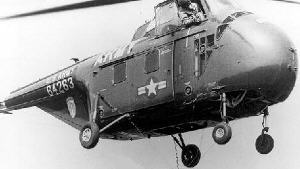
 1954 : The French Army ALAT
is the first to launch a missile from an Helicopter when a
SO.1221 Djinn fired a SS.10
1954 : The French Army ALAT
is the first to launch a missile from an Helicopter when a
SO.1221 Djinn fired a SS.10
 Early 1960s :
French forces used Piasecki H-21
twin rotor helicopters armed with rockets and machine guns in the
Algeria campaign.
But was the Vietnam War the breakthrough in this evolution.
The United States forces saw the necessity for more aerial fire support and more
importantly, a way to provide armed escort for cargo choppers.
( See Operation Shoofly ).
Early 1960s :
French forces used Piasecki H-21
twin rotor helicopters armed with rockets and machine guns in the
Algeria campaign.
But was the Vietnam War the breakthrough in this evolution.
The United States forces saw the necessity for more aerial fire support and more
importantly, a way to provide armed escort for cargo choppers.
( See Operation Shoofly ).
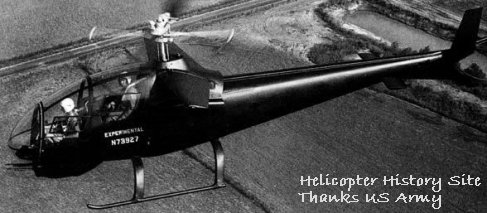
 1964 US Army AAFSS Program :
The Advanced Aerial Fire Support System
was the first american competition for a gunship and involved three contenders:
Bell D-262 ( a variant of the Iroquois Warrior ) ,
Sikorsky S-66 and
Lockheed C-840.
Lockheed 's entry was selected from this group and designated the
AH-56 Cheyenne
1964 US Army AAFSS Program :
The Advanced Aerial Fire Support System
was the first american competition for a gunship and involved three contenders:
Bell D-262 ( a variant of the Iroquois Warrior ) ,
Sikorsky S-66 and
Lockheed C-840.
Lockheed 's entry was selected from this group and designated the
AH-56 Cheyenne
 1965 Bell 209 HueyCobra :
While the US Army went forward with its sophisticated AAFSS,
Bell proceeded with its proposal now as a company-sponsored prototype.
Construction of this model was well advanced when the US Army called for
an interim gunship helicopter for service in Vietnam while the AH-56 was
still under development.
1965 Bell 209 HueyCobra :
While the US Army went forward with its sophisticated AAFSS,
Bell proceeded with its proposal now as a company-sponsored prototype.
Construction of this model was well advanced when the US Army called for
an interim gunship helicopter for service in Vietnam while the AH-56 was
still under development.
First flown in September 1965, the Bell 209 was selected in March 1966 as the new AH-1G HueyCobra in competition against gunship derivatives of Kaman Seasprite, Boeing Vertol Chinook (armed version used in Vietnam), Piasecki Pathfinder and Sikorsky S-61. Bell 's Cobra went into combat in September 1967.
Vietnam proved to be a major testing ground for the helicopter and a new form of warfare known as air mobility. No longer would armies fight each other along long fronts on the ground. Now they could be lifted deep into enemy territory, striking suddenly and powerfully.
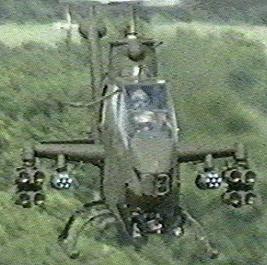
 Mil Mi-8 Hip E / F :
Like the Americans, the Soviet Union was developing the helicopter as an
attack aircraft as well. The heavy armed variants of the
Mil Mi-8 Hip were equipped
with a machine gun and wings, which held 6 rockets launchers and 4 anti tank
missiles.
Mil Mi-8 Hip E / F :
Like the Americans, the Soviet Union was developing the helicopter as an
attack aircraft as well. The heavy armed variants of the
Mil Mi-8 Hip were equipped
with a machine gun and wings, which held 6 rockets launchers and 4 anti tank
missiles.
But the most famous soviet armed helicopter was the following design by the Mil bureau : the Mil Mi-24 Hind which saw combat action in Afghanistan and in the African wars
 End 1960s World Wide :
End 1960s World Wide :
Most armies formed new air combat units using choppers armed with anti tank missiles like the AS.12 and TOW. These proved dramatically effective in the Arab/Israeli conflicts.
From this period on, helicopters became a vital piece military hardware in the inventory of most of the world 's powerful armies.
The French HAP ( seen at right ) is a Gazelle derivative and the German PAH-1 came from the MBB bo 105.
 Early 1970s :
The AH-56 contract was cancelled due financial and technical problems.
American companies soon launch new development programs like the
Sikorsky S-67 and the Bell 309 King Cobra
but both were later cancelled too.
Early 1970s :
The AH-56 contract was cancelled due financial and technical problems.
American companies soon launch new development programs like the
Sikorsky S-67 and the Bell 309 King Cobra
but both were later cancelled too.

 1972 US Army AAH Program :
Competition for the Advanced Attack Helicopter was between the
Hughes Model 77 (YAH-64)
and the Bell 409 (YAH-63).
Other contenders were the Boeing Vertol AAH and Lockheed CL-1700 a Cheyenne derivative.
1972 US Army AAH Program :
Competition for the Advanced Attack Helicopter was between the
Hughes Model 77 (YAH-64)
and the Bell 409 (YAH-63).
Other contenders were the Boeing Vertol AAH and Lockheed CL-1700 a Cheyenne derivative.
 Late 1970s :
Almost all helicopter manufactures offered armed variants of their
models, for example the
Hughes Defender
, the
Agusta A109
and the
Sikorsky S-76 Eagle
Late 1970s :
Almost all helicopter manufactures offered armed variants of their
models, for example the
Hughes Defender
, the
Agusta A109
and the
Sikorsky S-76 Eagle
 Since 1980s :
Other countries started developing new gunships :
Since 1980s :
Other countries started developing new gunships :
Italy produced the Agusta A.129 Mangusta ( Mongoose ) as an offshoot of its successful A.109
South Africa developed the Atlas Aviation CSH-2 Rooivalk. The first Atlas helicopter was the Alpha XH-1, a model originally derived from the Alouette III used by the South African armed forces for several years.
France and Germany joined forces to develop the Eurocopter Tiger
After Desert Storm, the United States developed new variants of existings models : AH-64D Longbow Apache and the Bell AH-1W+ Super Cobra.
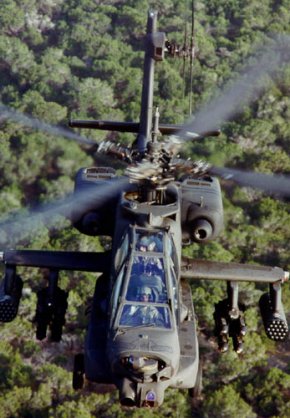
The demise of the Soviet Union, delayed the development of their last designs: the Mil Mi-28 Havoc and the Kamov Ka-50 / Ka-52 Hokum. All others programs, like the Kamov V-100, were cancelled
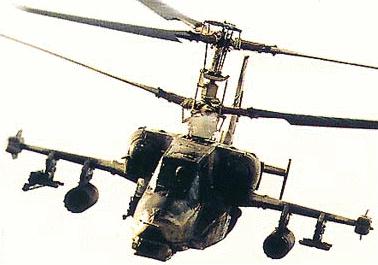
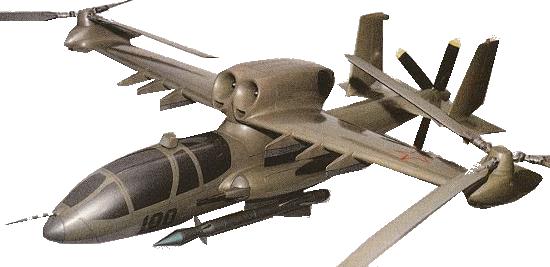
 After a 20 years program the US Army cancelled the Sikorsky / Boeing RAH-66 Comanche
in 2004 and award Bell a contract to build the ARH-70 Arapaho based on the civilian
Bell 407 which would be eventually cancelled too in 2008.
After a 20 years program the US Army cancelled the Sikorsky / Boeing RAH-66 Comanche
in 2004 and award Bell a contract to build the ARH-70 Arapaho based on the civilian
Bell 407 which would be eventually cancelled too in 2008.

The long war in Southeast Asia would see that change dramatically.
Technically, gunships and attack helicopters are not the same, though they can share the attack role. Gunships are modified aircraft to carry weapons, while attack helicopters are designed for only that role.
Great Britain and Russia did use autogiros ( based upon spaniard Cierva designs ) for observation duties but always used in small numbers.
Germany had already flown the Flettner FL 282 Kolibri , the most advanced helicopter model of this period and used it in combat for artillery spotting in Russia and for convoy protection in the Baltic and Mediterranean Sea so early as 1941. In the US, the Coast Guard was dropping practice bombs from a Sikorsky R-4 / YH-4A in early test as a weapon against submarines and the US Army succesfully complete a medevac (medical evacuation) mission in Burma at the ends of WWII using an YR-4.

An early link in the history of the helicopter gunship, was the proposal by Platt-LePage Aircraft to build a single seat dedicated gunship helicopter. This 1940 project was proposed at a time when Igor Sikorsky's VS-300 had yet to be perfected, and Platt-LePage Aircraft had not yet finished construction of its PL-3 (XR-1) helicopter. The Platt-LePage machine would have been a single seat 450 hp lateral tandem helicopter along the lines of the XR-1, with machine guns mounted in the nose, and eventually bomb mounts on the pylons. Also a Navy proposal would have had folding pylons for ship board storage. One interesting part of the proposal package, consisted of a series of artist's renderings showing how an armed helicopter would be used operationally. These renderings show essentially the same type of use and tactic that are used today. Unfortunately the idea was 20 years ahead of it's time, and was not bought by the US military, due to no operational helicopter existing in the USA at the time.
US Army start testing Bell 47 OH-13, Sikorsky S-51 H-19 and Piasecki H-21 with machine-gun pods and rockets.

Urgent demand by the US army for a new gunship helicopter equipped with the
newly designed turbo shaft engines (prior models used piston engines), pushed
Bell to develop the Iroquois Warrior , a revolutionary concept derived
from the Bell 204 Huey.
Bell finished a mock-up of the Iroquois Warrior in June 1962. It was a
Huey with wings, a slender fuselage and other features.
 Bell 207 Sioux Scout
Bell built a private-venture, concept-demonstrator looking for US army
support before developing its Iroquois Warrior.
This helicopter was a derivative of the succesful Bell 47.
Bell 207 Sioux Scout
Bell built a private-venture, concept-demonstrator looking for US army
support before developing its Iroquois Warrior.
This helicopter was a derivative of the succesful Bell 47.

First flown in September 1965, the Bell 209 was selected in March 1966 as the new AH-1G HueyCobra in competition against gunship derivatives of Kaman Seasprite, Boeing Vertol Chinook (armed version used in Vietnam), Piasecki Pathfinder and Sikorsky S-61. Bell 's Cobra went into combat in September 1967.
Vietnam proved to be a major testing ground for the helicopter and a new form of warfare known as air mobility. No longer would armies fight each other along long fronts on the ground. Now they could be lifted deep into enemy territory, striking suddenly and powerfully.

But the most famous soviet armed helicopter was the following design by the Mil bureau : the Mil Mi-24 Hind which saw combat action in Afghanistan and in the African wars
Most armies formed new air combat units using choppers armed with anti tank missiles like the AS.12 and TOW. These proved dramatically effective in the Arab/Israeli conflicts.
From this period on, helicopters became a vital piece military hardware in the inventory of most of the world 's powerful armies.
The French HAP ( seen at right ) is a Gazelle derivative and the German PAH-1 came from the MBB bo 105.

Italy produced the Agusta A.129 Mangusta ( Mongoose ) as an offshoot of its successful A.109
South Africa developed the Atlas Aviation CSH-2 Rooivalk. The first Atlas helicopter was the Alpha XH-1, a model originally derived from the Alouette III used by the South African armed forces for several years.
France and Germany joined forces to develop the Eurocopter Tiger
After Desert Storm, the United States developed new variants of existings models : AH-64D Longbow Apache and the Bell AH-1W+ Super Cobra.

The demise of the Soviet Union, delayed the development of their last designs: the Mil Mi-28 Havoc and the Kamov Ka-50 / Ka-52 Hokum. All others programs, like the Kamov V-100, were cancelled



